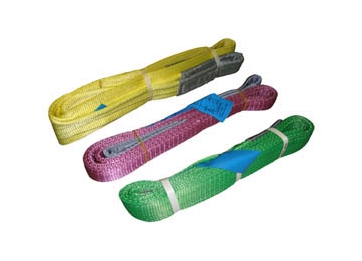Web Slings

Lifting slings or web slings are essential tools used in various industries for safely lifting and moving heavy loads. They are flexible, durable, and capable of distributing the load’s weight evenly to prevent damage to both the load and the sling itself.
Web slings are flexible lifting devices made from woven fabric or synthetic materials. They are designed to safely lift and move heavy loads in various industrial and commercial settings.
Here are the key features of web slings:
1.Material: Web slings are typically made from durable materials such as polyester, nylon, or polypropylene. These materials offer high tensile strength and resistance to abrasion, making
them suitable for lifting heavy loads.
2.Flexibility: Web slings are flexible and can adapt to the shape of the load being lifted. This flexibility allows them to securely cradle the load and distribute its weight evenly.
3.Load Distribution: Web slings have a wide surface area that helps distribute the load’s weight over a larger area. This minimizes the risk of damage to the load and provides stability during lifting.
4.Lightweight:Compared to some other types of lifting equipment like chain slings or wire rope slings, web slings are relatively lightweight. This feature makes them easy to handle and transport.
5.Non-Damaging:The soft nature of web sling materials makes them suitable for lifting delicate or sensitive loads. The fabric surface is less likely to cause damage or scratches to the load.
6.Versatility: Web slings are versatile and can be used for a wide range of lifting applications. They are suitable for lifting various types of loads, including irregularly shaped objects.
7.Various Configurations: Web slings come in different configurations, including flat web slings, endless web slings, and eye and eye web slings. Each configuration has its advantages for specific lifting scenarios.
8.Color Coding: Many manufacturers use color-coded labels or stripes to indicate the load capacity and type of web sling. This helps users quickly identify the sling’s specifications and ensure safe usage.
9.Ease of Inspection: Web slings are visually inspectable, allowing users to identify any signs of wear, damage, or degradation. Regular inspection is essential to maintain their safety and reliability.
10.Attachments: Web slings usually have loops or eyes at their ends to attach hooks, shackles, or other lifting hardware. These attachments provide secure connection points to the load and lifting equipment.
11.Cost-Effective: Web slings are often more affordable than alternatives like chain slings or wire rope slings, making them a cost-effective choice for many lifting applications.
12.Storage and Maintenance: Web slings are relatively easy to store and maintain. They should be stored in a dry and cool place to prevent degradation, and any damaged slings should be removed from service.
13.Safe Working Load (SWL): Each web sling is rated for a specific safe working load (SWL) that indicates the maximum weight it can safely lift. It’s crucial to ensure that the load being lifted does not exceed the sling’s SWL.
14.Regulations and Standards: Different regions and industries may have regulations and standards that dictate the design, manufacture, and usage of web slings. Adhering to these guidelines is essential for safe lifting operations.
Remember that proper training in the correct use, inspection, and maintenance of web slings is crucial to ensure the safety of both personnel and the loads being lifted.
